Sleep-Boosting Nursery Staples
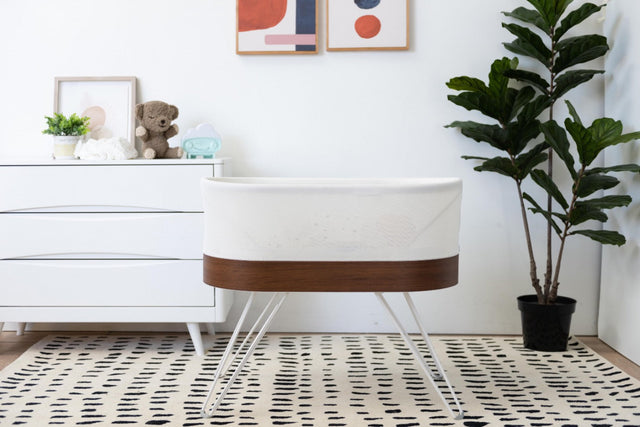
No matter if you’re putting together a whimsical nursery, a minimalist nursery, or one that’s brimming with sophistication, make sure your baby’s nursery also doubles as a sleep sanctuary that they’ll love to snooze in. After all, a good night’s rest is always in style! Here’s everything you need to know to create the ultimate sleep-inducing nursery for your little one.
Swaddle Blanket
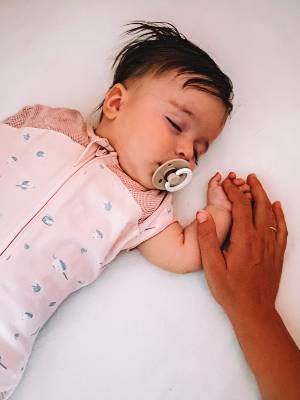
Swaddling is a key component to the 5 S’s for soothing babies, which means a swaddle blanket is a can’t-miss baby item to boost sleep. Wrapping your newborn in a swaddle blanket reminds them of the snug hug of the womb, activating their calming reflex, which is like nature’s “off switch” for crying and “on switch” for sleep. Using a swaddle blanket before laying your newborn down also helps to dampen their startle response, which also makes sleepytime easier.
Perhaps most importantly, a swaddle blanket is a safe alternative to using a loose blanket, which increases a baby’s chance of suffocation. To ensure the utmost safety, choose an easy-peasy “ready-made” zipper swaddle, like the multi-award-winning Sleepea 5-Second Swaddle, outfitted with “wings” that wrap your baby’s arms. It’s no wonder Sleepea was voted Best Easy Swaddle by Babylist, Easiest Swaddle to Use by What to Expect, and reviewers for New York Magazine’s The Strategist simply note that Sleepea is “magic.”
Blackout Curtains
While newborns can snooze almost anywhere, regardless of the sun, moon, or errant light streaming in, don’t be fooled! It won’t be long before all that peek-a-boo brightness keeps your bub from falling asleep—and staying asleep. Light exposure suppresses the production of the sleepytime hormone melatonin, which is needed to bring on the ZZZs. Plus, even a little bit of light can “trick” a baby into thinking it’s time to wake up. (Not fun at 5:30am!) Enter: Blackout curtains. While standard curtains offer varying degrees of light filtration, blackout curtains are specially designed to keep all light out, making them a baby registry must!
White Noise Machine
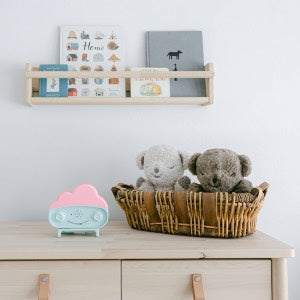
White noise is another key element to the scientifically-backed 5 S’s for soothing babies. Just like the beloved swaddle blanket, using a white noise machine that features continuous, monotonous, and low-pitch white noise helps turn on your baby’s built-in “reset button” to calm crying and bring on sleep. The ideal white noise for sleep copy-cats the loud rumbly sounds babies heard in the womb. The problem? The sounds in many noise machines—like crashing waves, heartbeat, chirping birds, and jungle sounds—don’t help babies sleep.
For pediatrician-approved, sleep-inducing white noise, try the Dr. Karp-designed SNOObear, a responsive on-the-go white noise lovey that “pays attention” to your tot, automatically turning on with soothing sounds if your child fusses. Another option is SNOObie, an adorable white noise machine that’s also a nightlight, sleep-trainer, and more. Both feature award-winning SNOO sounds, plus bonus relaxing tracks.
Bedtime Books
When selecting items to include on your baby registry, don’t forget books! First, add Dr. Harvey Karp’s bestselling The Happiest Baby on the Block so you can get all the expert advice you need to help your baby sleep great from the start. Next, select an array of rhythmic and calming board books to soothe your little one to sleep. (Pick from this list of favorite bedtime books.) Experts recommend reading before naptime and bedtime, likely because reading before night-night gives you and your love a chance to snuggle and connect—and it’s been shown to help calm babies and bring on the ZZZs. In fact, 81% of parents surveyed reported that reading to their little ones before lights-out helped their children fall asleep.
Customizable Nightlight
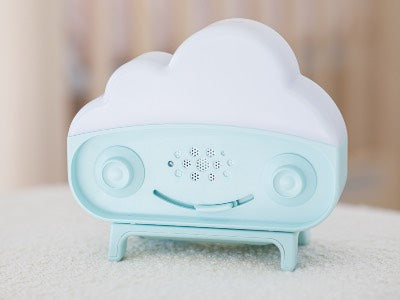
Newborns don’t need nightlights—you do! A dim nightlight allows you to check on your baby, change a diaper, or give a late-night feed without flipping on a too-bright sleep-disturbing light. But you know who else needs a nightlight? Toddlers and preschoolers! Many children this age feel a sense of comfort and safety if they can see familiar surroundings when they wake in the middle of night.
That’s why it’s smart to select a nightlight that works for the whole family, like the customizable SNOObie Smart Soother that allows for manual dimming, has an internal sensor that automatically adjusts brightness based on ambient light, and can be programmed to dim after tuck-in. You can choose between eight soothing colors, including warm red and orange tones that have been shown to help children sleep. (SNOObie is perfect for parents who want to buy less, too: SNOObie is a nightlight, sound machine, OK-to-wake clock, and more! Learn all about what SNOObie can do for you!)
Pacifiers
A pacifier’s ability to calm babies is “quite extraordinary,” says Dr. Karp. “Pacifiers can lower a baby’s heart rate, blood pressure, and stress levels—and they’re capable of triggering their innate calming reflex that brings on sleep.” That’s why Sucking is included in the 5 S’s for soothing babies, the calming technique taught in thousands of hospitals, parenting clinics, and military bases across the world.
Beyond a paci’s ability to help babies sleep, research shows that letting a baby suck on a binky while falling asleep can lower the risk of SIDS. Look for a one-piece, dishwasher-safe variety that’s appropriately sized for your baby’s age.
SNOO Smart Sleeper

The ultimate nursery item to boost sleep is the award-winning SNOO. Unlike run-of-the-mill baby bassinets and cribs, the pediatrician-designed Smart Sleeper has been shown to add 1 to 2 hours of sleep each night, thanks to SNOO’s built-in snug swaddle and constant womb-like motion and sound.
Adding to the bassinet’s sleep-boosting abilities: SNOO has specially designed sensors that automatically respond to your baby’s cries with an incremental uptick in calming white noise and rocking to lull babies back to sleep, often in under 1 minute. It’s no surprise why The New York Times wrote that “SNOO is in a class of its own,” further reporting that “SNOO proved to be effective at keeping [Baby] asleep longer than any other bassinet [we tested].
The icing on the cake? In 2023, SNOO became the first and only infant sleep system to receive De Novo authorization from the Food and Drug Administration for its ability to keep sleeping babies safely on their backs. Back-sleeping is the number one recommendation to help prevent SUID/SIDS from all major medical authorities. (For important safety information, please visit happiestbaby.com/fda.)
Overnight Diapers
Since leaky diapers wake babies up, it stands to reason that outfitting your little one in a proper nighttime diaper can help them sleep. That means, even if you’re keen on cloth diapers for the daytime, disposable diapers for overnight are likely your best bet for rest. After all, research shows that infants who wear disposable diapers sleep longer at night than babies who snooze in cloth diapers. To eke out even more sleep at night, consider getting specially designed overnight diapers that are outfitted with more pulp and super-absorbent gel than daytime diapers, which Consumer Reports have dubbed a “boon for any exhausted parent who just wants a few hours of consecutive sleep.”
Lovey
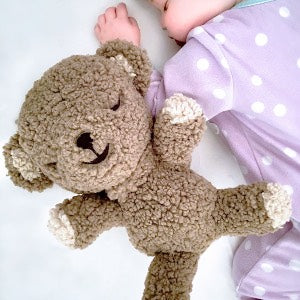
A lovey is way more than a cuddly stuffed animal or a silky blanket. “A cherished lovey can give little ones much-needed comfort, confidence, and security,” says Dr. Karp, who goes on to note that loveys are “a great sleep cue for older babies and toddlers,” too. In fact, the American Academy of Pediatrics (AAP) reports every child “needs” a comfort object in their early years for emotional support.
For safety reasons, you can’t leave a lovey in your baby’s crib or bassinet for their first year, however, it’s still important to introduce your baby to a lovey when they’re around 6 months old in order to start building that special sleep-promoting bond. Bring the lovey on walks, positioning it on the changing table, cuddle with it yourself so that your baby begins to associate it with comfort and security. For more comfort for your buck, consider SNOObear, a snuggly lovey that plays sleep-inducing white noise…and then “pays attention” to your tot, automatically turning back on with more soothing sounds if your bub cries or fusses…helping everyone sleep better.
Humidifier
According to the Sleep Foundation, using a humidifier at night can reduce a number of discomforts caused by dry air, which may help babies and big kids sleep more comfortably. That’s why Dr. Karp recommends using a cool mist humidifier (also called a vaporizer) in your baby’s nursery…especially (but not exclusively) during cold and flu season, in dry climates, and in high altitudes. “Humidifiers are great at naturally loosening nasal mucus and moisturizing irritated airways, helping children sleep comfortably,” he says. Some humidifiers, like the Canopy’s Nursery Humidifier, even come with an aroma diffuser, so you can add the relaxing scent of lavender to your baby's room while they snooze. Research in the International Journal of Pediatrics shows that aromatherapy that includes lavender can improve children’s sleep quality, their deep sleep, and it can reduce crying prior to falling asleep.
Smart Thermostat
A smart thermostat is one that can be controlled with your phone, a tablet, a smart speaker, or another kind of Wi-Fi-enabled device. Some of these thermostats (like the Nest) come equipped with temp-detecting sensors that give you room-by-room climate insights and controls. That means, you can guarantee your baby’s room is always set at the ideal temperature for sleep, which is between 68 to 72 degrees Fahrenheit (20 to 22.2 degrees Celsius). More than promoting ZZZs, the proper temperature helps ensure your baby does not overheat, which may reduce their risk of infant sleep death.